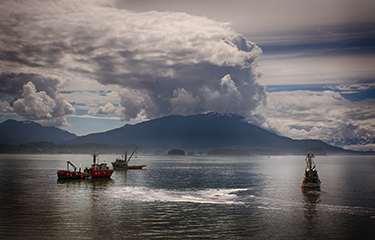Global supply of wild salmon is poised to increase in 2023 – particularly pink salmon, which alternates run sizes on a two-year cycle.
As a result, according to OBI Seafoods International Sales Manager Ron Risher, speaking during the salmon panel at the National Fisheries Institute Global Seafood Market Conference from 15 to 19 January in La Quinta, California, salmon runs in Alaska and Russia were down in 2022 but 2023 could see a big glut of some species.
“2022 was an even year for both Alaska and Russia; It’s a low run year for pink salmon because it’s a two-year cycle,” Risher said.
The one species in 2022 that saw large runs was sockeye, which resulted in bottlenecks at processing plants and a glut of headed-and-gutted sockeye compared to fillets.
“We had this phenomenal sockeye salmon run in Bristol Bay and it just eclipsed all the other sources,” Risher said.
Runs for pink salmon, meanwhile, were stable but non-peak, meaning they made up a much smaller percentage of the overall Pacific salmon catch in 2022. With a peak year coming in 2023, that will likely change.
Risher also noted a growth in the Japanese chum salmon catch, mainly caught in Hokkaido, the northernmost region of the country.
“We had a large chum salmon harvest, not so much from Alaska, which still remains at a five-year low, but coming mostly from Hokkaido on the hatchery-based fishery,” Risher said. “Japan has been increasing their chum salmon harvest over the past few years, and that has helped supply at least into that sector going into the Asian side.”
The effects of that increase on the U.S. fishery for chum salmon have been minimal, Risher said.
“We’ve still been able to maintain – there is a strong following for U.S. production of chum salmon,” Risher said. “We have seen those prices tick up over the last few years.”
However, in recent years, U.S. supply has made up a relatively minor part of global chum salmon production. In 2022, for example, the U.S. only produced 20 percent of the world's chum salmon – compared to 82 percent of the supply of sockeye salmon due to the record-breaking run in Bristol Bay.
“Then for our pink salmon run, it was for a non-peak year typical, but still lower than what we’ve seen in about the last five or six years,” Risher said.
Risher said the larger question for the wild salmon sector is how much Russian product will make it into global supply chains. Many countries, including the U.S., have issued sanctions or bans on Russian products in the wake of its invasion of Ukraine. A lot of Russian product, however, is still making its way into the U.S., Risher said.
“With Russia producing as many pink salmon as they normally do, it’s still been coming in through third countries for processing,” Risher said. “So China and other countries are still able to buy Russian-origin pink salmon.”
Thus far, Risher said, the U.S. has been hesitant to fully tap into the pink salmon coming from Russia.
“There’s been reluctance in the U.S. market to source double-frozen pink salmon portions from some of these countries, just so they can have the traceability on country of origin,” Risher said. “But it also becomes a price-driven thing as well.”
A glut of pink salmon in Russia in 2023 could result in more Russian salmon to making its way into Western markets after being processed in a third country.
“We’re still seeing these portions show up in Europe as well as other countries,” Risher said.
Another factor is the withdrawal of China’s “zero-Covid” policy, which will open up more processing capacity as Chinese processors get back up to speed.
While supplies of some salmon types are almost certain to increase in 2023, what the market will look like for that salmon is much less certain as inflation results in an economic downturn in some regions of the world.
“That is really concerning right now, just watching the economy in both the U.K. and Europe,” Risher said.
Seafood companies are considering a wider variety of products – such as smoked salmon – to see what product form can “help get consumers to look at wild salmon as an option," he said.
“We’ve seen some customers looking at different ways to market this product and help bring it to consumers' attention,” Risher said.
However, creating a different product requires some form of additional processing – and that means additional lead-times on products.
“You’ve got to look at taking a whole fish and converting that into a consumer-friendly product,” Risher said.
However, the glut of sockeye salmon and the popularity it maintained throughout the Covid-19 pandemic has helped elevate the category globally, Risher said.
“This salmon has staying power, it’s recognized by consumers around the world, and it gives a great opportunity for all species,” Risher said.
Photo courtesy of Maxim Gorishniak/Shutterstock







